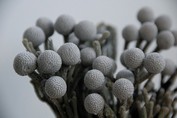 One flower I have been using over and over again in my designs is Brunia Berries. Not only do they add that touch of grey that is all so hot right now, they provide some excitement and whimsy within the designs. The neutral grey color coordinates well with all flowers. Besides that they are hardy, dry well and provide a unique texture. Botanical Name: Brunia Albiflora (BROO-nee-ah al-bih-FLOOR-ah) Brunia is native to South Africa, but is also commercially grown in California, Australia and New Zealand. There are several different varieties of brunia that are sold as a cut flower and colors can range from silver to green or red. The most common variety you see in floral designs is Brunia Nodiflora which has the very modern, chic, silver/ grey color. They are available most of the year with peak availability being June - December. Interesting Fact - Brunia Berries are not actually berries but ball shaped flowers. What do you think of Brunia Berries? Leave your comments below.
1 Comment
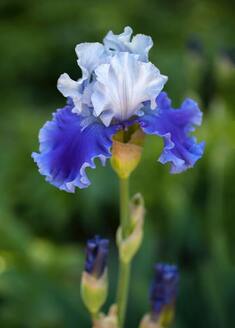 What do you think of when you see an Iris? Irises always take me back to my childhood. There were seas of yellow that seemed to go on forever, all the way around the house. The best part was that mom always let me cut some to bring inside. Did you know that Iris takes its name from the Greek word for rainbow, referring to the wide variety of colors found among the many species. Irises can be found in blue, purple, white, yellow, pink, orange, brown, red and even black. There are some 300 species in the genus Iris. Common Name: Iris Botanical Name: Iridaceae Irises are perennial plants. They have long, erect flowering stems which may be simple or branched, solid or hollow, and flattened or have a circular cross-section. The distinctive flowers have three large outer petals called "falls" and three inner upright petals called "standards." The falls may have beards or crests. Bearded iris are so-called because they have soft hairs along the center of the falls. In crested iris, the hairs form a comb or ridge. Most irises flower in early summer but most florist can have them imported year round. They are hardy, reliable, and easy to grow. Irises also attract butterflies and hummingbirds and make lovely cut flowers. What a great source on interest in a design. Interesting Facts:
 An old time favorite is making a come back, Babies Breath. Yes, this may just be your grandmother's favorite filler but before you judge and jump to conclusions, take a moment and consider all the truly wonderful possibility babies breath has to offer. Not only is it affordable and easy to find, it is also available all year round. Babies breath is also versatile, it works well with country, romantic and even vintage theme arrangements. Or to give it a modern feel use it in mass on its own and make it the star of the show. Common Name: Babies Breath Botanical Name: Gypsophila Gypsophila is a genus of about 100 species of flowering plants in the family Caryophyllaceae. Its botanical name means "lover of chalk", which is accurate in describing the type of soil in which this plant grows. It also means festivity, innocence, pure of heart, and happyness. With its teeny tiny blooms, it can look really elegant…and very, very pretty. As a fresh flowers it comes in white, sometimes with hints of pink, but babies breaths is also available dried in a variety of dyed colors. The best part, because Babies Breath is so easy to work with it's great for the DIY'er. Want some super cute ideas check out my Pintrest board, Babies Breath. Interesting Fact: The root of the Gypsophila repens is used to make the whipped-cream topping of the Turkish dessert kerebic. Boiling the root over a period of hours produces white bubbles which are collected, mixed with sugar, and mixed until it thickens to a cream. 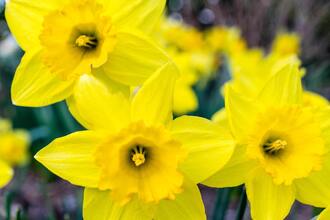 Daffodils, That come before the swallow dares, and take The winds of March with beauty. –William Shakespere, The Winter's Tale Usually thought of as a spring flower, and for good reason, Daffodils are ususlly seen in season starting in late December and lasting though April. I am always very happy to see the first Daffodil blooms, sometimes there is still a bit of snow on the ground when they start to poke through. This is always a sure sing to me that winter will soon be just a memory. Common Name: Daffodil Botanical Name: Narcissus Pseudonarcissus (nar-SIS-is sue-do-nar-SIS-is) Once again due to the wonders of greenhouses and the advancements in growing techniques, Daffodils are available wholesale year round as a cut flowers. There are as many as 60 different varieties grown in white, yellow and bi-color. Daffodils can have a single or double 1-3" corona white a 3-4" star-shaped back atop a 8-22' hollow stem. They are sure to add a cheerful feel to any arrangement. There are several possible stories on how/where the daffodil gets its name. One of the most common relates to the story of the young man of Greek mythology named Narcissus, who became so obsessed with his own reflection that as he knelt and gazed into a pool of water, he fell into the water and drowned. In some variations, he died of starvation and thirst from sitting by the edge of the pool, transfixed by his own reflection. In both versions, the Narcissus plant sprang from where he died. When cut, the trick is to keep the daffodils alone in a vase. Their stems secrete a sap that promotes the wilting of other flowers. If you must combine them, soak them by themselves for as long as possible, then rinse them and add them to the arrangement last without re-cutting the stems. Interesting Fact: Daffodils are grown commercially near Brecon in Powys, Wales, to produce galantamine, a drug used to combat Alzheimer's disease. 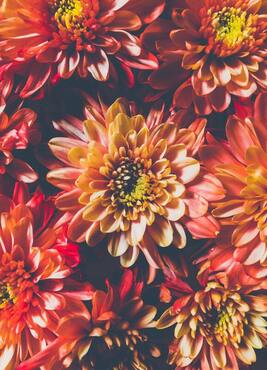 Chrysanthemums were first cultivated in China as a flowering herb as far back as the 15th century BC. Chrysanthemums are considered one of the four noble plants among bamboo, the plum, and the orchid. It was once believed that drinking from a stream that flowed between Chrysanthemums would help a person live to be 100. From this myth came Chrysanthemum tea, wine and medicine to encourage a healthy, long life. The chrysanthemum is also an edible flower. Common Name: Chrysanthemum, Mum Botanical Name: Chrysanthemum indicum Modern cultivated chrysanthemums are much more showy than their wild relatives. The flowers occur in various forms, and can be daisy-like, decorative, pompons or buttons. This genus contains many hybrids and thousands of cultivated varieties. In addition to the traditional yellow, other colors are available, such as white, purple, green, orange and red. Over 140 varieties of chrysanthemum have gained the Royal Horticultural Society's Award of Garden Merit. In general the Chrysanthemum symbolizes love, cheerfulness and optimism. It is also the birth flower for November, hence the reason to feature this flower this month. They can provide a wide variety of colors and textures to any floral design. Although they are thought of as a fall flower, chrysanthemums are available all year as a cut flower. The best part, they are super affordable. Interesting Fact: It was once thought that bringing a Chrysanthemum indoors meant a wishful death. 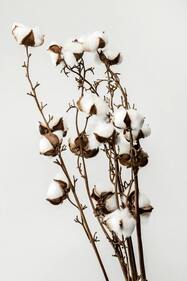 So once again I was undecided which flower I wanted to feature this month. I had been mulling it over all morning when I opened my inbox the answer was staring me in the face. One of my favorite suppliers had sent me an email about a product they had just got in. Yes, it was cotton branches. You may not think of cotton when thinking floral design and I want to ask you, why not? Cotton Branches adds a woodsy, earthy and very unique visual and textual statement when incorporated into a design. Here is a Pinterest link to a stunning bouquet using cotton branches. (While your there, make sure you follow me! Or if you need an invite let me know.) The best part, because cotton is a dried product, it is available all year. Common Name: Cotton Botanical Name: Gossypium Cotton is a soft, fluffy staple fiber that grows in a boll, or protective capsule, around the seeds of cotton plants. Generally grown on a shrub-like plant, the fiber is almost pure cellulose. Cotton fibers occur naturally in colors of white, brown, green, or some mixture of these. Cultivated cotton is also a major oilseed crop, as well as a main protein source for animal feed. Cotton plants thus have an enormous weight in the world economy and are of great importance for the agriculture, industry and trade of many tropical and subtropical countries in Africa, South America and Asia. Interesting Fact: Cotton is the traditional 2nd wedding anniversary gift. 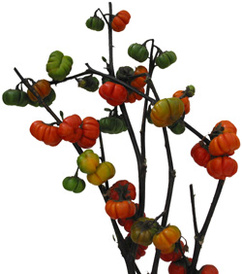 Have you ever heard of a Pumpkin Tree? or Pumpkin on a stick? If not you have been missing out. Pumpkin Tree has a very appropriate name, it really looks just like a tree branch with tiny pumpkins on it. This really cool looking decoration is becoming more popular in fall flower arrangements. It is always an attention getter and the best part, it lasts a very long time. Common Name: Pumpkin Tree, Pumpkin on a Stick, Pumpkin Bush Botanical Name: Solanum Integrifolium Pumpkin trees grow best in mild desert climates. The plant grows three to five feet tall. It produces ribbed fruit, about the size of a miniature pumpkin. As the fruit grows, it is a deep green color. The fruit ripens to a deep, reddish orange. When the fruit is dried, it's color lightens, appearing more orange in color. Interesting Fact: Pumpkin Tree is a member of the solanum family, which also includes the likes of potatoes and eggplants. As you might infer, this means the little pumpkin shaped fruits are quite different inside than their namesake. Inside it resembles a pepper, with loose seeds and a mild peppery taste. However, westerners tend not to like the flavor and prefer to use it ornamentaly. In Asian cooking, the tiny “pumpkin” peppers are more popular. 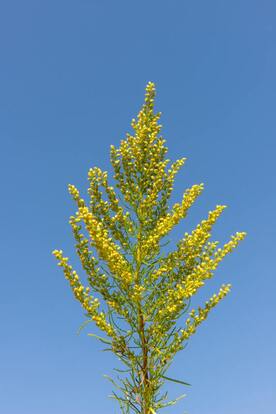 Solidago Solidago With allergy season upon us many people are suffering from the dreaded hay fever caused by Ragweed, including some members in my own family. Ragweed deserves the bad rap it has but a close relative does not, Solidgo. Solidago, used in floral design, is often unfairly blamed for causing hay fever. Solidago is not wind pollinated like Ragweed and will only causes allergic reactions when handled. Common Name: Goldenrod Botanical Name: Solidago (so-li-DAY-go) Providing a soft texture and a punch of bright yellow color, Solidago consists of closely packed clusters of very small flowers spreading like a feather on 20-30" branching stem. Also know as Goldenrod, Solidago is available all year and can be dried. If you can get past its weedy cousin, Solidago can be a lovely addition to any floral design. Meaning precaution, encouragement, and good fortune, this filler is very stunning. Interesting Fact: Thomas Edison experimented with goldenrod to produce rubber, which it contains naturally. Edison created a fertilization and cultivation process to maximize the rubber content in each plant. His experiments produced a 12-foot-tall plant that yielded as much as 12 percent rubber. The tires on the Model T given to him by his friend Henry Ford were made from goldenrod. Below is a great video to help you tell the difference between Solidago and Ragweed. 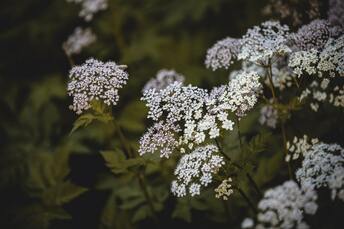 I was driving down the road and thinking to myself what flower should I feature this month. Then I realized my choice for this month's feature flower was easy. Right there in the ditch was my answer, Queen Anne's Lace. Meaning self-reliance, fantasy, haven, and delicate femininity. Queen Anne's Lace seems to be growing everywhere right now, adding it's beauty to the landscape. Common Name: Queen Anne's Lace, Wild Carrot Botanical Name: Ammi Majus (am-ME MAY-jus), Daucus carota Queen Anne's Lace also make a wonderful cut flower/filler. It is available all year long and is very inexpensive. With it's wispy, romantic, vintage look and you don't need a lot to make a statement. The overall shape reminds me of a firework when it explodes in the sky. The round, flat heads are usually 3-6" across consisting of hundred of small, white florets. The stem size can vary up to 36". Queen Anne's Lace can even be dried. One fable associated with the name of this plant describes the occasion of Queen Anne of England pricking her finger while working on lace, staining the lace with blood. If you look closely, you'll notice that each large `flower' has many small white florets with a red/purple dot in the middle. Like carnations, if you put them in a glass with water with food coloring, the flower will change color. Interesting Fact: Women have used the seeds from Daucus carota Queen Anne's Lace, as a contraceptive for centuries. 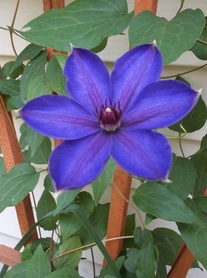 Purple Clematis Bloom For my latest flower of the month I chose the Clematis. I purchased my first plant last summer. Not being much of a green thumb, I just prayed I could keep it alive. Not only did it survive the summer, I was happy to see it come back this spring. This summer it seems to be doing extremely well (see pictures). Clematis flowers grow on a vine and blooms range in size from 1" - 7". They grow best in cool, moist, well-drained soil in full sun. I have noticed that my humming birds really like them as well. Available in purple, blue, pink, white and bi-color, clematis are becoming more popular in floral design. Clematises add that wild flower/garden feel while still providing a unique, elegant flower. Most clematises have Chinese or Japanese origins. 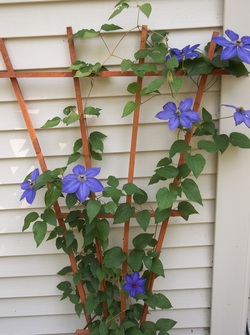 My Clematis Vine Common Name: Clematis Botanical Name: Clematis (KLEma-tis) The Western white clematis was called pepper vine by early travelers and pioneers of the American Old West. Taking a tip from Spanish colonials, seed and the acrid leaves were used as a pepper substitute. Unlike black pepper or Capsicum, however, the compounds in clematis cause internal bleeding of the digestive tract if ingested in large amounts. Despite its toxicity, Native Americans used very small amounts of clematis as an effective treatment for migraine headaches and nervous disorders. It was also used as an effective treatment of skin infections. Interesting Fact: Some clematis plants will change the color of their blooms though out the season. |
AuthorFaye K.-Owner/Designer at Blooming Envy since 2005. Categories
All
|

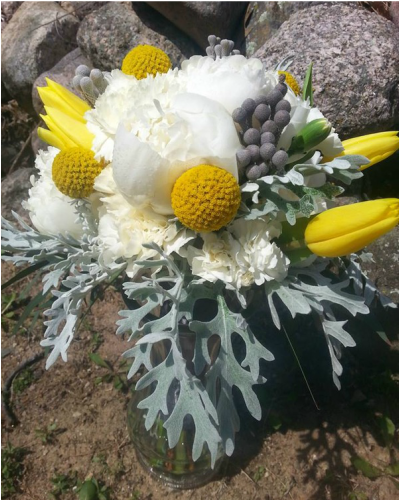
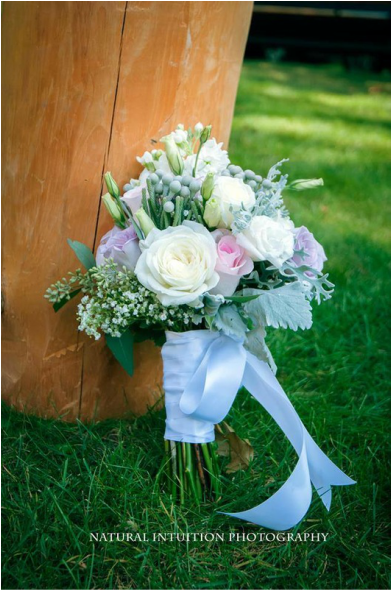
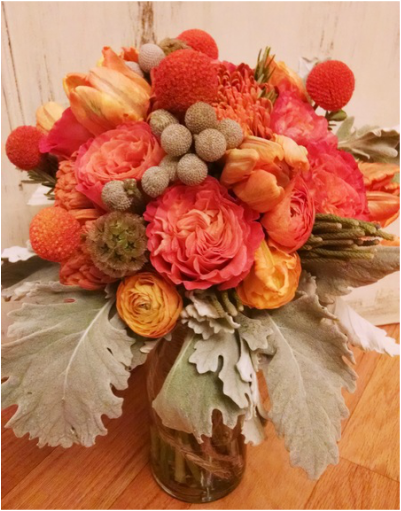
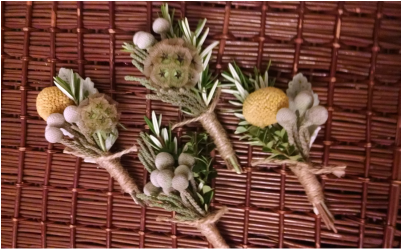
 RSS Feed
RSS Feed